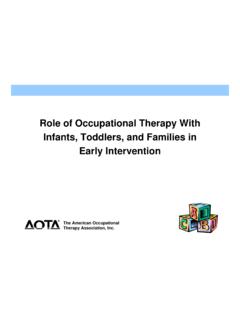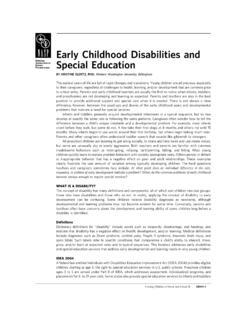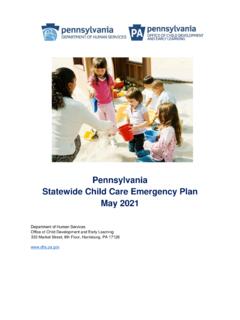Transcription of USER’S MANUAL - Transformations LLC
1 USER S MANUALCHILD & ADOLESCENT SERVICE INTENSITY INSTRUMENT FOR CHILDREN AND ADOLESCENTS AGES 6-18 VERSION User's MANUAL September, 2018 -- Version Child and Adolescent Service Intensity Instrument American Academy of Child and Adolescent Psychiatry ACKNOWLEDGMENTS The AACAP thanks the following individuals for their contribution of time and expertise: In the initial development of the instrument: Mark Chenven, , Emilio Dominguez, , Ted Fallon, Jr., , Katherine Grimes, , Graeme Hanson, , William Heffron, , Charlie Huffine, , Robert Klaehn, , Larry Marx, , Kieran O'Malley, , Andres Pumariega, , Tom Vaughan, Jr., , Wes Sowers, , Nancy Winters, , and Al Zachik, In the initial development of the training MANUAL : Robert L.
2 Klaehn, , Kieran O'Malley, , Kristin Kroeger Ptakowski, Tom Vaughan, In the initial field testing and evaluation of the instrument: Ted Fallon, Jr., , Andres Pumariega, In the refinement of the CASII: Debbie Carter, , Mark Chenven, , Ted Fallon, Jr., , Gordon Hodas, , Robert Klaehn, , Larry Marx, , Kaye McGinty, , Peter Metz, , Kieran O'Malley, , Andres Pumariega, , Nancy Winters, , Al Zachik, In the Version revisions: Peter Metz, , Mark Chenven, , Gordon Hodas, , Robert Klaehn, Andres Pumariega, , and Al Zachik, Other contributors: Ashley Green, Training on this instrument is strongly encouraged. Please contact the AACAP Clinical Practice Program Manager at 1- 800-333-7636. A special thank you to the Center for Mental Health Services, Substance Abuse Mental Health Services Administration for funding the initial field testing and evaluation of the instrument.
3 DISCLAIMER THE AMERICAN ACADEMY OF CHILD AND ADOLESCENT PSYCHIATRY DOES NOT ACCEPT LIABILITY FOR CLINICAL JUDGMENT AND/OR CLINICAL DECISIONS MADE THROUGH USE OF THIS INSTRUMENT, AS INTENDED OR FOR ANY OTHER USE, AND SHALL NOT BE LIABLE FOR ANY SPECIAL, INCIDENTAL, CONSEQUENTIAL, PUNITIVE, EXEMPLARY, OR OTHER INDIRECT DAMAGES, HOWSOEVER CAUSED, WHETHER ARISING IN CONTRACT, TORT OR OTHERWISE, IN CONNECTION WITH ITS USE OR IMPLEMENTATION. 1 2018 American Academy of Child and Adolescent Psychiatry. No part of this MANUAL may be reproduced without written permission. 2 2018 American Academy of Child and Adolescent part of this MANUAL may be reproduced without written permission. 3 2018 American Academy of Child and Adolescent part of this MANUAL may be reproduced without written permission.
4 TABLE OF CONTENTS INTRODUCTION ..5 SECTION I Historical Perspective ..9 Foundation and Principles ..11 SECTION II CASII Dimensional Rating System ..13 Levels of Service Intensity ..17 Level of Service Intensity Determination ..21 SECTION III CASII Instrument .. 23 Risk of Harm ..23 Functional Status ..25 Co-Occurrence of Conditions: Developmental, Medical, Substance Use, and Psychiatric .. 27 Recovery Environment ..31 *Environmental Stress ..32*Environmental Support ..33 Resiliency and/or Response to Services ..34 Involvement in Services ..36 * 37*Parent and/or Primary Caretaker ..38 Level of Service Intensity Utilization Criteria ..41 Level 0 Basic Services ..43 Level 1 Recovery Maintenance and Health Management ..44 Level 2 Outpatient Services.
5 45 Level 3 Intensive Outpatient Services ..47 Level 4 Intensive Integrated Services without 24-Hour Psychiatric Monitoring ..48 Level 5 Non-Secure 24-Hour Services with Psychiatric Monitoring ..50 Level 6 Secure 24-Hour Services with Psychiatric Management ..52 Level of Service Intensity Composite Score Table ..54 Level of Service Intensity Determination Grid ..55 SECTION IV Case Studies .. 57 CASII Post Training Questions ..69 CASII Post Training Answers ..74 Sample Questions for CASII ..79 ATTACHMENTS Appendix A: System of Care Guiding Values and Principles Updated ..87 Appendix B: Resources .. 89 Appendix C: CASII Psychometrics and Evidence .. 92 Appendix D: CASII Anchor Point Quick Reference Sheet .. 98 4 2018 American Academy of Child and Adolescent part of this MANUAL may be reproduced without written permission.
6 5 2018 American Academy of Child and Adolescent Psychiatry. No part of this MANUAL may be reproduced without written permission. INTRODUCTION This MANUAL was designed as a guide to the understanding and use of the Child and Adolescent Service Intensity Instrument (CASII), a comprehensive tool for evaluating service need for youth with mental health challenges. The first section describes the following key elements: the CASII's historical context; the principles guiding level of service intensity determinations; the biopsychosocial dimensions used in the CASII evaluation; and a description of the various levels of service intensity responses. The second section provides a detailed description of the dimensions and the levels of care.
7 Section three provides material used in training, including: case studies, post test questions, and sample questions for collecting information to help complete the CASII. Appendices provide information regarding the System of Care concept and philosophy, a list of resources and a review of the CASII psychometrics. The CASII was created in response to clinicians, program managers, utilizations reviewers and administrators who called for the development of a common framework for making decisions on the level of service intensity needed in the behavioral health treatment of children and adolescents, and to monitor progress over time. The current evolving framework of health care reform places emphasis on the use of validated and reliable metrics to guide treatment needs and monitor outcomes (Wotring & Stroul, 2011).
8 The CASII is such a metric. The CASII is based on the Level of Care Utilization System (LOCUS) developed for use with adults, but has been adapted to reflect a developmental perspective, family focus, and inclusion of the comprehensive array of services in systems that serve children and adolescents. The instrument was developed collaboratively by the American Academy of Child and Adolescent Psychiatry (AACAP) with the American Association of Community Psychiatrists in 2001 and first named the CA-LOCUS. Subsequent refinement of the tool has moved from a primary concern with "level of care" to a broader perspective involving intensity of overall need, with a focus on services and integrated service coordination, resulting in the renaming of the instrument to CASII.
9 In most cases, the CASII may be applied to children ages 6 through 18 years. Because the service needs of infants and toddlers are fundamentally different than those of older children, they are excluded from the CASII evaluations. The service intensity needs of children under the age of 6 years should be determined by use of the early Childhood Service Intensity Instrument (ECSII), developed by the AACAP in 2009. The CASII draws from clinical experience and a number of values, principles, and resources, including: CASSP/Guiding Principles for Systems of Care (1983): This approach has been theprimary value base of SAMHSA and State Health and Human Services for the past 30years. The System of Care values and principles call for care that is family-driven andyouth-guided, culturally competent, strength-based, coordinated, community-based andleast restrictive, emphasizing early intervention and prevention, transition to adulthood,and outcomes-based.
10 (Stroul, Blau, and Friedman, System of Care Values and PrinciplesUpdated; Stroul and Blau, Handbook of System of Care; Winters, Pumariega, et al,6 2018 American Academy of Child and Adolescent Psychiatry. No part of this MANUAL may be reproduced without written permission. 2007). In recent years, the System of Care approach has also incorporated wellness, prevention, and early intervention as part of its overall commitment. Developmental theory (Harris, 1995; Gilmore and Meersand, 2014), which describes the trajectory of normative physical, emotional, cognitive, and social changes of childhood and adolescents, to be addressed in both assessment and treatment. Cultural competence (Cross et al., 1998; Pumariega, et al, 2013), which embodies respectfor people of all ethnic backgrounds, accommodation of their needs and priorities ( appropriate assessment and treatment, linguistic support) and wheneverpossible, provision of services by culturally competent professionals and staff memberswhose ethnic diversity mirrors that of the populations served.






